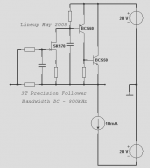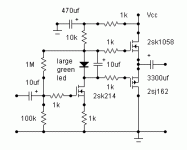Scott, Bob Widlar told me to build my own preamplifier designs and not to descend to using IC's, (like you make), for audio, at an ISSCC conference in 1974. Ask Walt Jung, if you don't believe me.
>Scott, Bob Widlar told me to build
>my own preamplifier designs and
>not to descend to using IC's,
>(like you make), for audio, at an
>ISSCC conference in 1974.
>Ask Walt Jung, if you don't believe me.
That was 1974 ....
>my own preamplifier designs and
>not to descend to using IC's,
>(like you make), for audio, at an
>ISSCC conference in 1974.
>Ask Walt Jung, if you don't believe me.
That was 1974 ....
Yes, as Scott is bitching about Bob Widlar in 1968, and his opinions on fet design. You might notice that the last schematic by Bob Widlar shown here had fets as current sources. He just knew their limitations at the time.
>You might notice that the last schematic
>by Bob Widlar shown here had fets as
>current sources. He just knew
>their limitations at the time.
So there are some fet devices out now
that transcend the ones available in 1974 ?
>by Bob Widlar shown here had fets as
>current sources. He just knew
>their limitations at the time.
So there are some fet devices out now
that transcend the ones available in 1974 ?
PMA said:I have a better one - what is this?
john curl said:.... You might notice that the last schematic by Bob Widlar shown here had fets as current sources. ....
JFET as input device.
I never thought I should come to this. Have always been a bipolar 'BC550C-lover'. ( you can see this in my posts at this board, 2002, 2003 etc. )
But lately I have change my mind. Influenced by such great amplifier men as Nelson Pass and John Curl.
Comparing JFET and lownoise BJT in spice models is something I can recommend.
PMA is doing some good work here. Thanks!
BJT has some advantages. As have JFET.
But everything else being equal, my choice for amplifier input stages
... is JFET 😎
I am no fundamentalist.
I can change my mind and have no problems use whatever kind of device,
if I find this one does the job better.
Not accepteing all options at hand, at a special time, is too limit your self from what you can possibly design.
Even if you love them TUBES, you may need a transistor some time. Be it bipolar or FET.
Besides, 90 % of us listens, daily!, to not only discrete transistors, but a bunch of IC Chips as well.
Because this is the stuff what modern audio gears are made of.
And if you own system have only FETS or TUBES in signal chains,
you may be sure that the CD/Vinyl production companies have used IC Chips ...
to bring you some music.
==========================
I attach a super follower. Made up of 3 common Transisitors.
Highest quality I get from using a JFET to control VOLTAGE
while using BJT lownoise/high beta as CURRENT Helpers.
Regards, Lineup 🙂
Attachments
OK design, about 1970, over-complex, slow for RF because of added compensation.
This is John's new 'red pencil' service to encourage evaluation of new designs.
This is John's new 'red pencil' service to encourage evaluation of new designs.
At the very minimum, mirror the existing circuit with P-ch (and N) devices. Better yet, get out a clean sheet of paper.
Grey
Grey
It's really four transistors because of the CCS.
Eliminate the resistor from output directly to input?
Eliminate the resistor from output directly to input?
john curl said:OK design, about 1970, over-complex, slow for RF because of added compensation.
This is John's new 'red pencil' service to encourage evaluation of new designs.
Thanks, john.
> slow for RF
rf = radio frequencies
I do not find this is major drawback for audio band apps = AF
But I have carefully noted your design preference: SPEED!
Like 7 years ago you once told me: CURRENT is GOOD!
I have never forgotten this and also found out you were right.
Now, current and speed and slewrate 'walk hand in hand'.
So your ideas match ...
For example, you like to run JFETs with a good portion of Current level.
It is true we can 'starve' JFETs, in order to improve some parameters.
But it is not really worth it, 9 times out of 10,
because of the loss of some more important parameters.
---------------------
Also like to thank you for two other advices on JFET designs:
John Curl:
- Do not add gate stopper resistance.
- Do not add source resistance.
.. unless you will really need it 🙂
I had a N-JFET differental circuit in my spice program.
Of course 🙁 I had added resistors all over. Gate and source and you name it ...
This is what we normally see. And seeing is an influence on mind.
'Monkey see, monkey do'
Anyway, after reading this John Curl advice, I ripped out all those gate/source resistance,
and guess what ... 😎 my circuit was considerably IMPROVED in performance.
( I use AC analyse, Freq +Phase and FFT, with upto 15th harmonic. )
-------
There is also another Curl finding regarding 'bad harmonic'.
The seventh harmonic is something to watch out for!
Evenso MORE than 3rd and 5th.
I can also verify WHY this makes very good sense.
It has to do with chords in music.
And the 12 note tempered scale we use in western world music.
C-E-G = The Major chord of fundamental frequency of 'C'
Second harmonics is another 'C' .. one octave higher.
This is why it does Not Sound very annoying, even if this is an addition we do not want.
Because,
if J. S. Bach would have wanted another 'C' one octave up, he would have written so.
No matter how 'good it sounds' .. it is not High fidelity, HI-FI.
Not fidel, not true to the music of Johan Sebastian Bach as his original artwork.
Much Regards
Lineup
john curl said:I would hope so. What do you think?
When did the 2sk170 come out ?
From my limited perspective that
is still the standard for audio.
No, the part number of the jfet. You know: 1.2.3.4...101.102... Think about when the 170 came into being.
john curl said:Latest design, '60's derivation from bipolar. Crude, full of distortion, cap coupling.
An externally hosted image should be here but it was not working when we last tested it.
se
Previous design commented on, all solid state, is found in principle on p. 66 of the 5th edition the 'General Electric Transistor Manual' 1960. I knew that I had seen it somewhere. Anyone have editions 4,3,2,or 1 of the 'GE Transistor Manual'?
john curl said:Anyone have editions 4,3,2,or 1 of the 'GE Transistor Manual'?
Most of those seem to be available on the web from various sources. Google "General Electric Transistor Manual" and you'll find quite a few hits for them. Most of them under $20.
se
- Status
- Not open for further replies.
- Home
- Amplifiers
- Solid State
- John Curl's Blowtorch preamplifier

